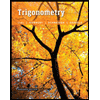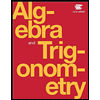**Question** Find the equation of the graph given below. Notice that the sine function is used in the answer template, representing a sine function that is shifted and/or reflected. Use the variable \( x \) in your equation, but be careful not to use the multiplication \( x \) symbol. **Graph Description:** - A sinusoidal graph is shown, resembling a sine curve. - The graph crosses specific points: \( \left(\frac{\pi}{4}, 1\right) \) and \( \left(\frac{3\pi}{4}, 1\right) \). - The amplitude of the wave appears to be centered around \( y=1 \) with oscillations between \( y=2 \) and \( y=0 \). **Axes:** - The horizontal axis represents the \( x \)-values, labeled at intervals \( 0, \frac{\pi}{2}, \pi \). - The vertical axis represents the \( y \)-values, ranging from \(-1\) to \(3\). **Prompt:** Provide your answer below: \[ y = \square \sin(\square) + (\square) \]
**Question** Find the equation of the graph given below. Notice that the sine function is used in the answer template, representing a sine function that is shifted and/or reflected. Use the variable \( x \) in your equation, but be careful not to use the multiplication \( x \) symbol. **Graph Description:** - A sinusoidal graph is shown, resembling a sine curve. - The graph crosses specific points: \( \left(\frac{\pi}{4}, 1\right) \) and \( \left(\frac{3\pi}{4}, 1\right) \). - The amplitude of the wave appears to be centered around \( y=1 \) with oscillations between \( y=2 \) and \( y=0 \). **Axes:** - The horizontal axis represents the \( x \)-values, labeled at intervals \( 0, \frac{\pi}{2}, \pi \). - The vertical axis represents the \( y \)-values, ranging from \(-1\) to \(3\). **Prompt:** Provide your answer below: \[ y = \square \sin(\square) + (\square) \]
Trigonometry (11th Edition)
11th Edition
ISBN:9780134217437
Author:Margaret L. Lial, John Hornsby, David I. Schneider, Callie Daniels
Publisher:Margaret L. Lial, John Hornsby, David I. Schneider, Callie Daniels
Chapter1: Trigonometric Functions
Section: Chapter Questions
Problem 1RE:
1. Give the measures of the complement and the supplement of an angle measuring 35°.
Related questions
Question
![**Question**
Find the equation of the graph given below. Notice that the sine function is used in the answer template, representing a sine function that is shifted and/or reflected.
Use the variable \( x \) in your equation, but be careful not to use the multiplication \( x \) symbol.
**Graph Description:**
- A sinusoidal graph is shown, resembling a sine curve.
- The graph crosses specific points: \( \left(\frac{\pi}{4}, 1\right) \) and \( \left(\frac{3\pi}{4}, 1\right) \).
- The amplitude of the wave appears to be centered around \( y=1 \) with oscillations between \( y=2 \) and \( y=0 \).
**Axes:**
- The horizontal axis represents the \( x \)-values, labeled at intervals \( 0, \frac{\pi}{2}, \pi \).
- The vertical axis represents the \( y \)-values, ranging from \(-1\) to \(3\).
**Prompt:**
Provide your answer below:
\[ y = \square \sin(\square) + (\square) \]](/v2/_next/image?url=https%3A%2F%2Fcontent.bartleby.com%2Fqna-images%2Fquestion%2F210ef24a-00e7-4179-8f1e-410e45889c5f%2F3f22fcf6-8e4e-4d65-b9b5-79f644595926%2Fz142qx.jpeg&w=3840&q=75)
Transcribed Image Text:**Question**
Find the equation of the graph given below. Notice that the sine function is used in the answer template, representing a sine function that is shifted and/or reflected.
Use the variable \( x \) in your equation, but be careful not to use the multiplication \( x \) symbol.
**Graph Description:**
- A sinusoidal graph is shown, resembling a sine curve.
- The graph crosses specific points: \( \left(\frac{\pi}{4}, 1\right) \) and \( \left(\frac{3\pi}{4}, 1\right) \).
- The amplitude of the wave appears to be centered around \( y=1 \) with oscillations between \( y=2 \) and \( y=0 \).
**Axes:**
- The horizontal axis represents the \( x \)-values, labeled at intervals \( 0, \frac{\pi}{2}, \pi \).
- The vertical axis represents the \( y \)-values, ranging from \(-1\) to \(3\).
**Prompt:**
Provide your answer below:
\[ y = \square \sin(\square) + (\square) \]
Expert Solution
This question has been solved!
Explore an expertly crafted, step-by-step solution for a thorough understanding of key concepts.
This is a popular solution!
Trending now
This is a popular solution!
Step by step
Solved in 2 steps with 1 images

Recommended textbooks for you

Trigonometry (11th Edition)
Trigonometry
ISBN:
9780134217437
Author:
Margaret L. Lial, John Hornsby, David I. Schneider, Callie Daniels
Publisher:
PEARSON

Trigonometry (MindTap Course List)
Trigonometry
ISBN:
9781305652224
Author:
Charles P. McKeague, Mark D. Turner
Publisher:
Cengage Learning


Trigonometry (11th Edition)
Trigonometry
ISBN:
9780134217437
Author:
Margaret L. Lial, John Hornsby, David I. Schneider, Callie Daniels
Publisher:
PEARSON

Trigonometry (MindTap Course List)
Trigonometry
ISBN:
9781305652224
Author:
Charles P. McKeague, Mark D. Turner
Publisher:
Cengage Learning


Trigonometry (MindTap Course List)
Trigonometry
ISBN:
9781337278461
Author:
Ron Larson
Publisher:
Cengage Learning